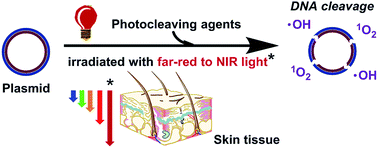DNA photo-cleaving agents in the far-red to near-infrared range – a review
Abstract
Photosensitizing agents that oxidatively cleave DNA are important to photodynamic therapy (PDT), an emerging treatment option for patients diagnosed with age-related macular degeneration, pre-cancerous conditions such as Barrett's esophagus, and localized cancers that include inoperable neoplasms. Excitation with low energy irradiation activates the PDT agents, causing spatially targeted, oxidative damage to DNA and other macromolecules in diseased cells. While most routinely used PDT photosensitizers rely on visible light sources that emit at wavelengths ≤689 nm, excitation that extends from the far-red into the near-infrared wavelength range is desirable. Due to low absorption by biogenic chromophores, light in this region has a greater penetration depth through tissue when compared to visible irradiation that is higher in energy. In the present review, we describe the development of new, long wavelength DNA photo-oxidizing agents. We have attempted to correlate the structural elements of the photosensitizers with their reported light-induced nuclease activities (λex ≥ 690 nm). Reaction pathways that lead to DNA cleavage are discussed, including 3O2 dependent Type I electron transfer and Type II energy transfer processes and anaerobic Type I hydrogen atom abstraction from deoxyribose. The summary discussion contained in this review is intended to contribute to the discovery of new phototherapeutic agents that are activated with far-red to near-infrared light.


 Please wait while we load your content...
Please wait while we load your content...